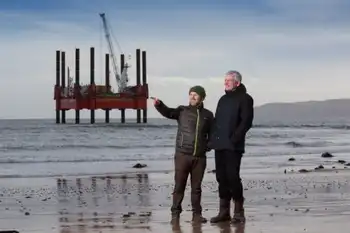NaiKun Wind an emerging wind producer
Suddenly, every one appears to be concerned about the climate, environment, greenhouse gas emissions and renewable energy. And about time too!
Clearly, renewable energy such as wind power, hydropower and solar power are gaining the prominence they deserve. They will enjoy even greater recognition when the world economy finally comes out of recession and oil prices reach their former dizzying heights. All these developments are expected to strengthen the investment case of companies engaged in power generation through renewable sources.
We have been developing a theme around renewable energy and have been following companies that are making progress in this space. Well away from the glamour in Copenhagen and potentially beneath the radar of many an investor, Canadian Venture listed NaiKun Wind Energy Group Inc. is making steady progress in its efforts to be a premier wind energy generator in North America.
Located in northwest British Columbia, the companyÂ’s initial project is designed to have a generating capacity of 396MW. From the provinceÂ’s point of view, the NaiKun Wind project can play an important role in helping B.C. reach its goal of becoming electricity self-sufficient by 2016 while also providing major economic benefits to North Coast communities.
Currently, with an installed wind energy capacity of just over 100MW, B.C. stands to benefit greatly from having companies such as NaiKun provide electricity to the grid. NaiKun’s planned Phase 1 generating capacity of 396MW represents merely 2% of B.C.’s total annual electricity consumption and would take the province just part of the way toward its ambitious self-sufficiency goal (imports currently comprise about 15% of energy use). Even after taking into account the five-phase plan to reach a total generating capacity of 1,750 – 2,000MW, the company would satisfy only 11% of the fiscal 2007 BC Hydro load.
One would think that from BC HydroÂ’s point of view, NaiKun represents a welcome partner to its energy party. For starters, NaiKunÂ’s output peaks in winter when hydro-based generating assets are operating at their lowest capacity. Without alternative suppliers such as NaiKun, BC Hydro would be forced to buy energy from out of province. But even that option disappears in 2016 owing to the self-sufficiency requirement mandated by provincial government policy. Clearly, NaiKunÂ’s business strategy fits well with B.C.Â’s wind energy aspirations. The company is participating in the provincial utilityÂ’s ongoing power call which, after a significant delay, seems to be drawing close to conclusion and the award of contracts to successful proponents.
NaiKun has done all the right things during its march to where it is now. Careful analysis of potential sites to locate its project, detailed environmental impact studies to meet the B.C. governmentÂ’s rigorous standards and building relationships with First Nation communities are some of the important activities NaiKun has carried out with enviable success. In addition, NaiKun has finalized the transmission route, seabed analysis and identification of Siemens as the turbine and transmission system supplier for the 396MW project. The company also has 15 years of wind data correlated with readings from its LIDAR-based meteorological mast operating at the project site since September 2007.
NaiKunÂ’s project site is in Hecate Strait, between Haida Gwaii and Prince Rupert. This is an area known for high wind speeds year-round which would keep home fires burning, or in NaiKunÂ’s case, turbines turning. Some of our readers were specifically querying us about high capital costs associated with offshore wind farms and if that would impair the profitability of NaiKunÂ’s operations.
In NaiKunÂ’s case, although capital costs are up to 35% greater than those for onshore installations, this is more than adequately compensated for by the higher capacity factor provided by the planar wind offshore and the areaÂ’s unique geography. Compared to a net capacity factor of 15-30% for an onshore wind farm, NaiKunÂ’s project enjoys a net capacity factor in excess of 40%.
A further indication of operational viability arrived on December 10 of this year when the British Columbia Environmental Assessment Office (EAO) awarded Phase 1 a provincial Environmental Assessment Certificate. The NaiKun project underwent a harmonized provincial/federal review led by the EAO which concluded the project will have no significant environmental, social or health effects on the surrounding area. The federal governmentÂ’s decision on the environmental assessment application is expected in early 2010 and will be based on the results of the harmonized review. The Haida Nation has also undertaken an environmental assessment of the project. These and other developments are paving the way for construction for the initial phase of CanadaÂ’s first offshore wind farm. Future phases would be contingent upon, among other things, First Nations consultation and appropriate government approvals.
Unlike many companies in the renewable energy space NaiKun is not cash strapped either. The company has over $10 million in the treasury and is looking forward to two significant cash inflows in 2010 – one from a second strategic partner for the 396MW project and the other a $69 million development fee to be received upon financial close. Given the progress the company is making, NaiKun appears to be well on its way to achieve its target to generate power by 2013/2014.
As the world demand for environmentally friendly energy sources increases, companies such as NaiKun can be expected to attract growing investor attention. The company is moving forward with its development endeavours and is achieving milestones one after the other. The recent Environmental Assessment Certificate is just the latest example of the kind of good news investors can expect from NaiKun.
Related News

UK Renewable Energy Auction: Boost for Wind and Tidal Power
ENGLAND - In a significant development for the UK’s renewable energy sector, the latest auction for renewable energy contracts has underscored a transformative shift towards wind and tidal power. As reported by The Guardian, the auction results reveal a strong commitment to expanding these technologies, marking a pivotal moment in the UK’s transition to cleaner energy sources.
The Auction’s Impact
The renewable energy auction, which took place recently, has allocated contracts for a substantial increase in wind and tidal power projects. This auction, part of the UK’s Contracts for Difference (CfD) scheme, is designed to support the development of low-carbon…




